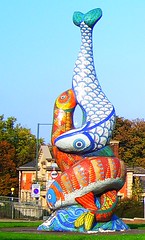Erith, land of sheds
Categories: circumnavigation
Tags: southeastlondon, naturalhistory, urbanwalks, trees
Date: 15 October 2007 03:16:54
The centre of Erith is marked by a giant brightly-coloured ceramic sculpture of three-in-a-bed oral fish sex right by the great big roundabout in front of the Town Hall. The photos is work-friendly, unless your boss is a moralising, monagamist herring.
Why Erith? I'm still trying to redirect Stuff and Thingy towards south-east London (if only because of the looming East
Greenwich) so I dreamed up the idea of trying out the bus routes but an 89 came before the 108 so I got on it instead to see where it went and it went to almost to Slade Green. Almost because the passengers - myself, one small drunk old lady, and about two dozen 14 or 15 year-old white boys from Bexleyheath with short hair and crutches whose idea of fun was talking very loudly about how well they had handled themselves at some mythical fight outside a nightclub, saying not-at-all work-friendly things about young women and the size of their genitals, planning to defraud the railway company, and running up and down the stairs screaming - all got kicked off outside a pub about two stops short of Slade Green station at a council estate with and a view of the Dartford Bridge, and some real ships. Big ones.
So I walked back towards London and found myself walking up a long gently curving dual carriageway with giant sheds on either side. Not garden sheds but the sort of huge aluminium clad box that could contain a shop or a factory or a warehouse, and mostly did, this being the nearest London has to a genuine industrial area.
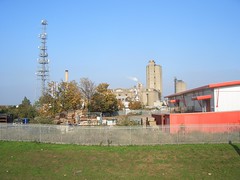
|
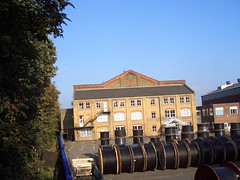
|
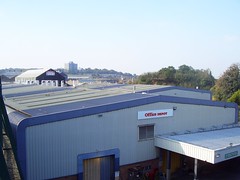
|
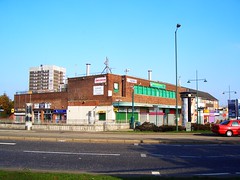
|
That, as far as Lesnes Abbey (which there is more of left than I thought - you can clearly see the ground-plan where the church used to be) and I got bored of dual carriageways and sheds and so into the woods. Lesnes Abbey Wood to start with (hence "Abbey Wood" station) and over to Plumstead to meet up with the place the walk of a fortnight ago ended.
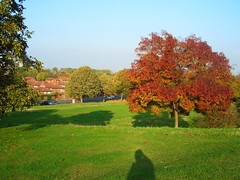
|
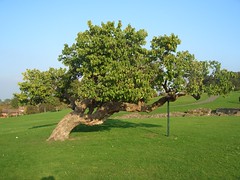
|

|
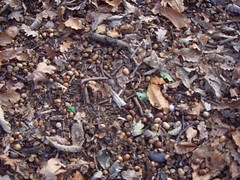
|
Once upon a time British botanists indulged themselves in a futile Quest for a Genuine Wild Wood (our version of the almost as futile Quest for the Historical Jesus) with various naturalists putting forward the argument for this that or the other stand of trees never having been felled for agriculture or for some reason resembling a real natural woodland. Whatever that is, as in these islands humans are older than the woods, we've been here longer. We have lots of so-called "ancient woods" that have been around since before about 1600, but there are probably no woods that were never managed by humans, at least for a few centuries (and some of them for many centuries continually).
And it is not clear whether or not a "natural" Natural British Woodland would be one that resembles the woods that existed before the introduction of agriculture, or one that resembles the woods that might have existed had agriculture never been introduced,or one that had never been subjected to agriculture, or one that contains only native British species (that is plants that got here between the ice going away and the North Sea coming back), or one that resembles the woodlands that might have been here at this stage in previous ice ages, or one that was simply left alone to look after itself for a few centuries - and all of those are different.

|
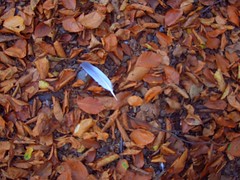
|
Whatever, there are a dozen or so bits of woodland in England that someone or other claims to be the last, or the only, or the best, or the biggest piece of wildwood in the country. And apart from a two or three really weird stunted oakwoods in the north or west (and ignoring the claims of the some of the obviously artificial old deer parks such as Hatfield or Hainault or Petworth or Epping or the New Forest which preserve an artificially high density of large grazing animals which makes them in some ways more "natural" than any other woods since our ancestors killed off the mammoths and bison and wild cattle) just about all tof them are in historical Kent and Sussex, and some of the best ones now in the more industrialised suburbs of South East London, including Abbey Wood and Oxleas wood only a short busride away, which preserve more of the look and feel of the ancient countryside of England than just about anywhere else in the country, in bits of dogwalking rough land on the hills between some of London's grottier council estates. Someone noticed a few years ago and invented the Green Chain Walk which (if unlike me, you don't like walking through the council estates and industrial areas and concretey bits) will take your from Crystal Palace to the Thames at Erith through as many (more?) diverse little woodlands as any other walk in England.
But the most notable wood today wasn't one of the ancient ones at all. I've never been to Bostall Wood before. Its lovely. Or at least the part of it I wandered through is. A very strange wood, hard to read. The trees on the flat past of the wood that I walked through are are mostly beech and birch. No ash or oak, not even a sycamore, but there is the occasional pine. Very little undergrowth, easy to walk through (which might be because so many people and dogs walk through it) and apparently very few characteristic woodland herbaceaous plants (though maybe thats because this is October, I should go back in April or May) The nearest to an understory is holly, with some brambles around, there seems to be or very little if any hazel or elder or small oak (though the steep edges of the wood are full of oak). Just over the road in Lesnes Abbey Woods I'd seen oak and ash and elder and hornbeam and holly and some cherries or other Prunus and Viburnum andClematis and ivy and dozens of other plants.

|
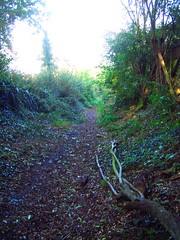
|
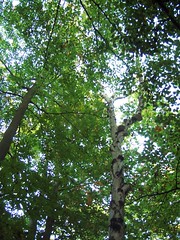
|
Here its quite different. Nearly all the tree trunks are quite thin - is that because they are close together or just because they are still quite young? Its obviously quite a new wood.
Most of the trees are perhaps not much older than I am. But is it self-seeded or planted? And who plants dense beech woods, or birch at all? And if self-seeded why no ash or sycamore? They get anywhere. Or oak? There is abundant oak, piles of acorns, just hundreds or even tens of metres away. And where did those pines come from? Did this use to be a golf course or some kind of public park?
Whatever the reason for it (whcih I might be able to disover by looking at my bookshelf but I haven't yet because its more fun speculating) It's beautiful. The ground is covered with golden-bronze beech-leaves and crunchy beech-mast. There are park benches to sit on, from the Green Chain Walk people. The sunset filters through the trees wonderfully. It smells nice.

|

|
